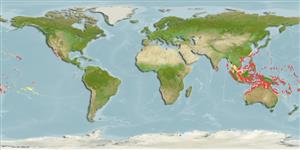Common names from other countries
Environment: milieu / climate zone / depth range / distribution range
Ecologia
marinhas associadas(os) a recifes; intervalo de profundidade 3 - 50 m (Ref. 27115), usually 6 - 30 m (Ref. 48637). Tropical; 21°C - 27°C (Ref. 27115); 30°N - 30°S
Pacific Ocean: Philippines to the Line Islands, north to southern Japan, south to northwestern Australia and New South Wales.
Tamanho / Peso / Idade
Maturity: Lm ? range ? - ? cm
Max length : 12.0 cm TL macho/indeterminado; (Ref. 9710)
Espinhos dorsais (total) : 7; Raios dorsais moles (total) : 24 - 26; Espinhos anais: 1; Raios anais moles: 22 - 25; Vértebras: 26. Pale blue to light bluish gray in color. Operculum with 2 broad, curved, bright blue bands. 4 to 6 median barbels (like bumps in juveniles). 2nd spine of 2nd dorsal fin elongated; caudal fin of adults with trailing filaments; diagonally elongate red to violet spot usually present on lower base of pectoral fin.
Inhabits coastal reef slopes in a depth range of about 6 to 30 meters depth (Ref. 48637). Found over rubble and sand near reefs. Usually seen in pairs occupying the same burrow. It uses burrows made by alpheid shrimps which live in association with gobies of the genus Amblyeleotris, but does not interact with the shrimps. Feeds on zooplanktons (Ref. 89972).
Life cycle and mating behavior
Maturities | Reprodução | Spawnings | Egg(s) | Fecundities | Larvas
Randall, J.E. and D.F. Hoese, 1985. Revision of the Indo-Pacific dartfishes, genus Ptereleotris (Perciformes: Gobioidei). Indo-Pac. Fish. (7):36 p. (Ref. 528)
Categoria na Lista Vermelha da IUCN (Ref. 130435)
CITES (Ref. 128078)
Not Evaluated
Ameaça para o homem
Harmless
Utilização humana
Pescarias: espécies comerciais; Aquário: Espécies comerciais
Ferramentas
Relatórios especiais
Descarregue XML
Fontes da internet
Estimates based on models
Preferred temperature (Ref.
115969): 25.4 - 29, mean 28 (based on 772 cells).
Phylogenetic diversity index (Ref.
82804): PD
50 = 0.5000 [Uniqueness, from 0.5 = low to 2.0 = high].
Bayesian length-weight: a=0.00389 (0.00180 - 0.00842), b=3.12 (2.94 - 3.30), in cm Total Length, based on all LWR estimates for this body shape (Ref.
93245).
Nível Trófico (Ref.
69278): 3.4 ±0.4 se; based on size and trophs of closest relatives
Fishing Vulnerability (Ref.
59153): Low vulnerability (10 of 100).
